Buchanan Field Airport (CCR)
Buchanan Field Airport (CCR) is a medium sized, primarily general and business aviation airport located in the city of Concord, CA, just northeast of the San Francisco – Oakland Bay area. Its location just outside the SFO Class Bravo airspace makes it an attractive alternative to pilots visiting the area, and it is home to no less than three major flight schools. The mix of itinerant, student, and locally based pilots and aircraft, makes CCR a challenging airport for both controllers and pilots. View a printable Pilot Handbook of the CCR information found on this Web page.
Know Before You Go
- The airspace at CCR is Class D with a ceiling up to and including 2500’ MSL. It also underlies San Francisco Class B Airspace and the 30 NM Mode C and ADS-B Out veil. (Refer to Sectional Chart)
Below find various CCR-specific information and things to be aware of, as well as general information to inform your preflight planning. This will be reviewed quarterly and updated as needed. This information is to supplement the From the Flight Deck Videos that are produced by the FAA Runway Safety Group. Here you will also find information provided by the local air traffic controllers at the airport where you intend to fly. The information is subject to change. Not for navigation or legal* pre-flight action. Always refer to official pre-flight materials such as, but not limited to, NOTAMs, airport diagrams, VFR charts and airport construction notices for the latest airport-specific details.
CCR Tower Operates from 0800L to 2300L Daily
Administrative Office Open 0800L to 1600L – Monday through Friday
Business Phone 925-685-5743
Hot Spots
HS 1 Pilots departing the RWY 32L run-up area sometimes mistake TWY J for
RWY 32L.
HS 2 Complex intersection at RWY 01R/19L, TWY J, TWY A, TWY C and TWY K.
HS 3 Pilots on TWY A sometimes fail to comply with hold short instructions for RWY
32L approach area and/or fail to proceed completely through RWY 32L
approach area when instructed by ATC.
HS 4 Aircraft approaching RWY 32R from TWY B, TWY J, and the run-up area often
cross the RWY holding position without ATC authorization.
General
- Pilots inbound from the north have sometimes confused Napa County Airport with Buchanan. While the runway configuration is not the same, the airports are close enough to occasionally cause confusion.
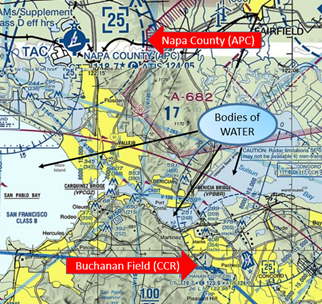
- The airport configuration at CCR consists of two sets of parallel runways with staggered thresholds.
- As with any airport with similar runway configurations, wrong surface arrivals and departures have occurred.
- There are several full-length parallel taxiways that have led to some confusion
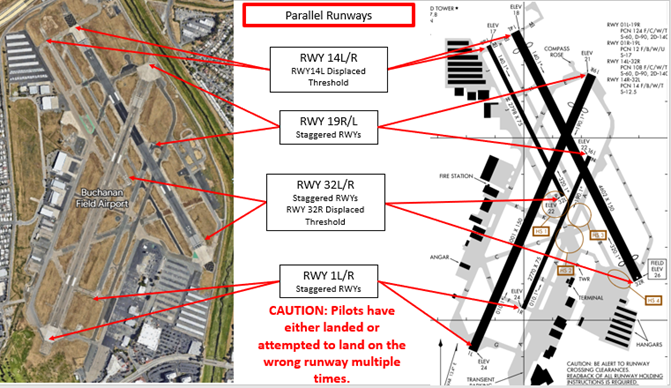
Departure
- Verify proper heading prior to starting takeoff roll on all full-length and intersection departures. Wrong Surface Takeoff risk exists at this airport.
- Pilots in the Run-Up Area for RWY 19 have mistaken TWY A for the RWY and attempted to takeoff on the TWY.
Landing
- The PAPI on RWY 01L and RWY 32R does not provide obstruction clearance beyond 4.0 NM from the threshold.
- Wrong Surface Landing risk exists. See Arrival Alert Notices.
- Pilots inbound from the N/NW and instructed to make a straight-in or right base entry to RWY 19R have mistaken RWY 14L as their assigned RWY (as illustrated below).
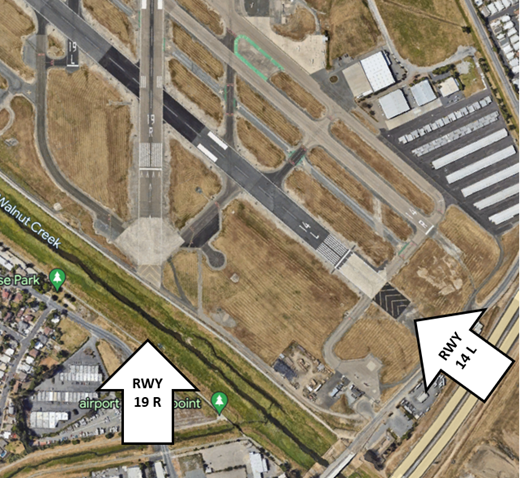
Surface Risk – Movement Area
- RWY 01R/19L pavement has high severity block cracking, longitudinal and transverse cracking, patching, and weathering.
- Several Hot Spots and other areas of concern are associated with run-up areas. The taxiway system at CCR is complex and close reference to the Airport Diagram is recommended.
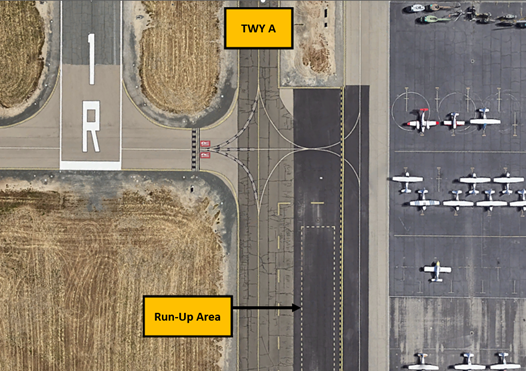
The above picture illustrates the run-up area for RWY 01R. It is located east of TWY A, south of TWY F between TWY A and the large ramp area to the east.
The following picture illustrates Hotspot 1, where pilots exiting the RWY 32L run-up area with clearance for takeoff, sometimes mistake TWY J for RWY 32L.
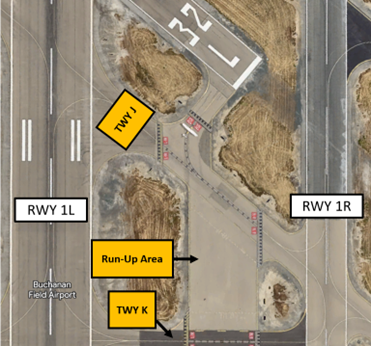
Hotspot 2 is a complex intersection of multiple taxiways. The intersection of TWYs A, J, and C can be confusing and can lead to a runway incursion onto RWY 1R/19L.
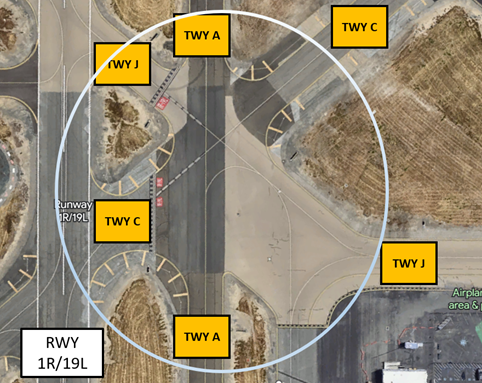
At Hot Spot 3, pilots taxiing either north or south on TWY A, fail to hold short of the RWY 32L Approach Hold Short Line when instructed.
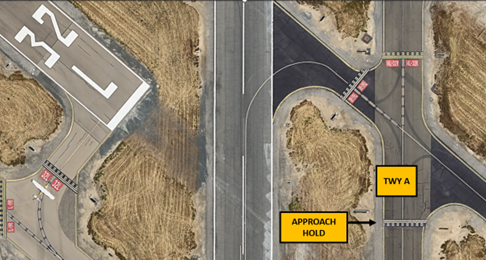
Not listed as a Hot Spot but like Hot Spot 1, pilots in the run-up area for RWY 19L have mistaken TWY A for the runway. (Illustrated below.)
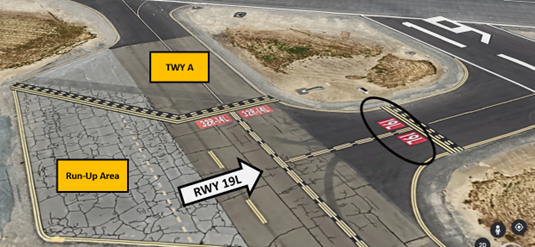
- At Hot Spot 4, pilots are completing their run-up and taxiing across the RWY 32R Hold Short marking, possibly because it is located a considerable distance from the RWY 32 edge and approach end. (See airport diagram.)
- Pilots departing the transient ramp at the south end of the airport have confused TWYs A and G
General
- If unsure about any instructions, please ask for clarification.
- We do our best to accommodate all requests but sometimes we are unable due to traffic workload, complexity or safety.
Traffic Patterns
- We try to accommodate pilots when they request the longer runway but these requests area addressed dependent upon traffic.
- Please make the request for a short approach or early turnout before executing the procedure.
- We may be unable to accommodate short approaches with multiple aircraft in the pattern.
Ground
- On initial contact, please request the RWY that most aligns with your direction of flight.
- Read back ALL hold short instructions and ALL RWY assignments with your call sign.
- Ask for progressive instructions if you are unsure or unfamiliar.
- Stay on TWR frequency when in between active parallel RWYs.
Take-off/Departure
- Ask before you depart, when requesting an early turnout.
- Depart in the direction that most aligns with your on-course heading.
- Be aware that IFR aircraft departing RWY 19R making a left downwind turn to the VOR will affect aircraft departing RWY 19L.
- Avoid crossing over any approach corridor without prior coordination with TWR.
Arrival/Landing
- For smoother handling, avoid calling at the Class D area boundary. Call earlier - at least 7 to 10 miles out.
- Do not mistakenly line up for RWY 14 when assigned RWY 19 or vice versa.
- Avoid crossing over the approach/departure corridor especially when on RWY 01L/R.
- Be accurate and specific about your location, i.e., 10 miles north, northeast, east.
- When calling inbound, please be specific with your relative bearing from the airport.
- Listen to specific pattern entry instructions. We may need you to enter the downwind even though you are set up for a base entry.
- Stay on TWR frequency when in between active parallel RWYs.
Avoidance Areas
- Aircraft that are requesting turns that cross the departure course or the final approach course for any runway should initiate that request with TWR prior to executing the turn.
- Be aware of noise abatement restricted areas.
Noise Abatement
- Noise abatement is for all aircraft. Here is the link for further information from the county’s website. https://www.contracosta.ca.gov/3804/Buchanan-Field-Noise-Program
